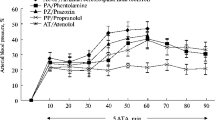We report here our studies of the effects of electrical stimulation of the vagus nerve on the development of oxygen convulsions and cardiovascular reactions in hyperbaric oxygen (HBO2). The motor signs of the neurotoxic action of HBO2 were identified in conscious rabbits exposed to O2 at 5 atm, along with EEG, ECG, external respiration, and brain blood filling in conditions of stimulation of the cervical component of the vagus nerve. Oxygen convulsions were found to be preceded by increased sympathetic tone, with a specific EEG pattern (synchronization of slow waves), changes in the ECG (tachycardia) and respiration (hyperventilation). Vagal stimulation enhanced the parasympathetic component of the autonomic system and significantly delayed the prodromal signs of oxygen toxicity and the onset of convulsions. Afferent spike activity from the visceral organs is regarded as a new target for countering the neurotoxic effects of hyperbaric oxygen.
Similar content being viewed by others
References
P. M. Gramenitskii and P. A. Sorokin, “On the mechanism of changes in respiration and circulation in dogs exposed to high-pressure oxygen,” in: Body Functions in Altered Environmental Gas Conditions, G. L. Zal’tsman (ed.), Nauka, Leningrad (1964), pp. 91–105.
A. G. Zhironkin, Oxygen. Physiological and Toxic Actions, Nauka, Leningrad (1972).
S. Yu. Zhilyaev, A. M. Moskvin, T. F. Platonova, et al., “Hyperoxic vasoconstriction in the brain is mediated by inactivation of nitric oxide by superoxide anions,” Ros. Fiziol. Zh., 88, No. 5, 553–550 (2002).
G. L. Zal’tsman, V. P. Ponomarev, and A. I. Selivra, “Bioelectrical activity of various brain centers in the process of formation of oxygen epilepsy in dogs,” in: Hyperbaric Epilepsy and Narcosis, G. L. Zal’tsman (ed.), Nauka, Leningrad (1968), pp. 47–69.
A. N. Moskvin and Yu. I. Luchakov, “Oxygen tension in the brain in hyperoxia in rats,” Byull. Eksperim. Biol. Med., 154, No. 10, 429–431 (2012).
I. A. Sapov, “Mechanisms of the toxic actions of oxygen on pulmonary tissue,” Byull. Eksperim. Biol. Med., 35, 40–45 (1953).
A. A. Savich, “Motor signs and brain bioelectrical activity on formation of oxygen epilepsy in rabbits,” in: Hyperbaric Epilepsy and Narcosis, G. L. Zal’tsman (ed.), Nauka, Leningrad (1968), pp. 36–46.
A. I. Selivra, Hyperbaric Oxygenation. Physiological Mechanisms of the Reactions of the Central Nervous System to Hyperoxia, Nauka, Lenin grad (1983).
M. Aalbers, J. Vles, S. Klinkenberg, and G. Hoogland, “Animal models for vagus nerve stimulation in epilepsy,” Exp. Neurol., 230, No. 2, 167–175 (2011).
M. Majoie and K. Rijkers, and B. A. Duncan, “Investigation into the mechanisms of vagus nerve stimulation for the treatment of intractable epilepsy, using 99mTc-HMPAO SPET brain images,” Eur. J. Nucl. Mol. Imaging, 30, No. 2, 301–305 (2003).
E. E. Benarroch, “The central autonomic network: functional organization, dysfunction and perspective,” Mayo Clin. Proc., 68, No. 10, 988–1001 (1993).
L. L. Carpenter, F. A. Moreno, M. A. Kling, et al., “Effect of vagus nerve stimulation on cerebrospinal fl uid monoamine metabolites, norepinephrine and gamma-aminobutyric acid concentrations in depressed patients,” Biol. Psychiatry, 56, No. 6, 418–426 (2004).
M. H. Chase, Y. Nakamura, C. D. Clemente, and M. B. Sterman, “Afferent vagal stimulation: neurographic correlates of induced EEG synchronization and desynchronization,” Brain Res., 5, No. 2, 236–249 (1967).
J. B. Dean, D. K. Mulkey, A. J. Garcia, III, et al., “Neuronal sensitivity to hyperoxia, hypercapnia, and inert gases at hyperbaric pressures,” J. Appl. Physiol., 95, No. 3, 883–909 (2003).
I. T. Demchenko, S. Y. Zhilyaev, A. N. Moskvin, et al., “Autonomic activation links CNS oxygen toxicity to acute cardiogenic pulmonary injury,” Am. J. Physiol. Lung Cell. Mol. Physiol., 300, No. 1, L102–L111 (2011).
I. T. Demchenko, S. Y. Zhilyaev, A. N. Moskvin, et al., “Barorefl exmediated cardiovascular responses to hyperbaric oxygen,” J. Appl. Physiol., 115, No. 6,819–828 (2013).
I. T. Demchenko, H. G. Gasier, S. Y. Zhilyaev, et al., “Baroreceptor afferents modulate brain excitation and infl uence susceptibility to toxic effects of hyperbaric oxygen,” J. Appl. Physiol., 117, No. 5, 525–534 (2014).
I. T. Demchenko, K. E. Welty-Wolf, B. W. Allen, and C. A. Piantadosi, “Similar but not the same normobaric and hyperbaric pulmonary oxygen toxicity, the role of nitric oxide,” Am. J. Physiol. Lung Cell. Mol. Physiol., 293, No. 1, L229–L238 (2007).
M. Dixon, D. M. Woodbury, and J. W. Woodbury, “Effects of vagal stimulation on experimentally induced seizures in rats,” Epilepsia, 31, Suppl. 2, 7–19 (1990).
E. E. Fanselow, F. P. Reid, and A. L. Nicolelis, “Reduction of pentylenetetrazole-induced seizure activity in awake rats by seizure-triggered trigeminal nerve stimulation,” J. Neurosci., 20, No. 21, 8160–8168 (2000).
M. S. George, Z. Nahas, D. E. Bohning, et al., “Vagus nerve stimulation: a new form of therapeutic brain stimulation,” CNS Spectr., 5, No. 11, 43–52 (2000).
Z. J. Gieroba and W. W. Blessing, “Fos-containing neurons in medulla and pons after unilateral stimulation of the afferent abdominal vagus in conscious rabbits,” Neuroscience, 59, No. 4, 851–858 (1994).
D. Jamieson and H. A. Van Den Brenk, “Pulmonary damage due to high pressure oxygen breathing in rats,” Aust. J. Exp. Biol. Med. Sci., 40, 309–314 (1962).
Author information
Authors and Affiliations
Corresponding author
Additional information
Translated from Rossiiskii Fiziologicheskii Zhurnal imeni I. M. Sechenova, Vol. 101, No. 11, pp. 1279–1288, November, 2015.
Rights and permissions
About this article
Cite this article
Zhilyaev, S.Y., Moskvin, A.N., Platonova, T.F. et al. Electrical Stimulation of the Vagus Nerve Modulates the Development of Oxygen Epilepsy in Rabbits. Neurosci Behav Physi 47, 345–351 (2017). https://doi.org/10.1007/s11055-017-0403-5
Received:
Revised:
Published:
Issue Date:
DOI: https://doi.org/10.1007/s11055-017-0403-5




